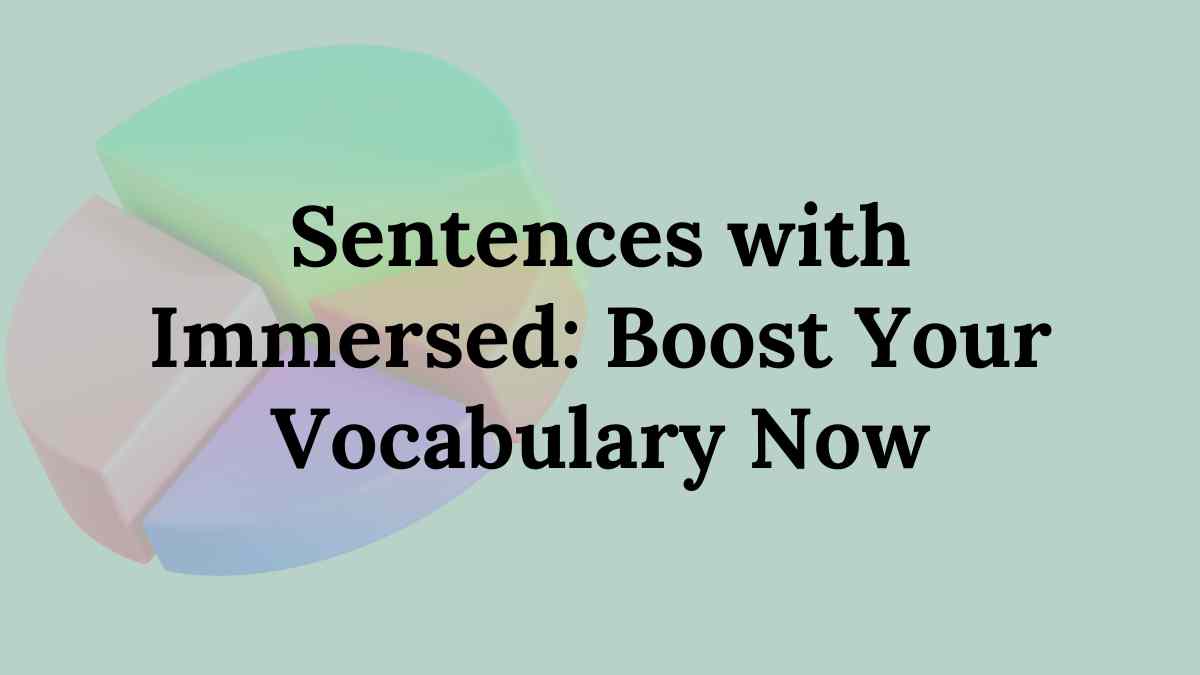Learning English grammar and expanding your vocabulary are essential steps toward achieving fluency. A strong vocabulary allows you to express ideas clearly, understand others better, and communicate with confidence in both writing and speaking.
One of the most effective ways to improve your language skills is by mastering words in different contexts. Understanding how a word is used in various situations helps you remember it better and use it more naturally in conversation or writing.
In this blog post, we will explore sentences with immersed, a powerful word that conveys depth, involvement, and focus. Whether you are an English learner or an educator, this post will guide you on how to use immersion effectively and enrich your vocabulary.
Let’s dive in and see how immersive learning can transform your English skills!
What Does Immersed Mean?
Before we jump into sentences with immersed, let’s first understand its meaning. Immersed is a verb that generally means to be deeply engaged or involved in something. It could be a physical immersion, like being submerged in water, or a figurative immersion, like being deeply involved in an activity or subject.
For example:
- She was immersed in her book, unaware of the time.
- He became immersed in learning the piano.
In both cases, immersed shows how fully involved someone is, whether physically or mentally.
10 Powerful Sentences with Immersed
Now, let’s look at 10 powerful sentences with immersed that will help you grasp its usage more effectively. These sentences will allow learners and educators to see how the word works in different contexts and help expand their vocabulary with immersed.
1. She was immersed in learning Spanish to improve her skills.
In this context, immersed in learning refers to an individual who is not just passively studying but is fully and deeply engaged in the process of acquiring a new language. This person is surrounded by the language at every opportunity, whether through reading, listening, speaking, or writing, thus becoming fully involved in the learning journey. Using sentences with immersed like this one can help demonstrate how someone can be completely absorbed in their educational experience, making learning not just a task but an immersive and enriching part of their daily life.
2. The students were immersed in the history of World War II during their studies.
Here, immersed in suggests that the students were not just casually participating but were thoroughly involved in their research or the process of learning about a specific topic. They were deeply engaged, dedicating their time and focus entirely to the subject matter. This concept is clearly illustrated through sentences with immersed, as it emphasizes how an individual can become fully absorbed in a task or learning experience, often losing track of time as they explore and dive deeper into the topic at hand.
3. He was completely immersed in the beauty of the underwater world while scuba diving.
This example in sentences with immersed describes someone physically submerged in water, surrounded by nature, and fully enveloped in the natural environment. It emphasizes not just the physical act of immersion but also the emotional and sensory experience of being completely absorbed in a peaceful and tranquil setting. Sentences with immersed like this help convey a deeper connection between the individual and their surroundings, showing that immersion goes beyond the surface to include full sensory engagement with the environment.
4. Maria has been immersed in digital marketing for years, becoming an expert.
In this case, immersed ” is used figuratively to describe someone who has been deeply involved in a career or field of study for a long period, dedicating both time and effort to mastering their craft. This usage highlights not just the physical commitment but also the mental and emotional engagement that comes with prolonged focus and expertise. Sentences with immersed used in this way convey the depth of involvement, illustrating how a person’s identity and purpose are intertwined with their work or field of study, making it a central part of their life.
5. The teacher encouraged the class to be immersed in the new book they were reading.
Here, the teacher wants the students to engage deeply with the text, indicating a form of mental immersion where they are encouraged to go beyond surface-level reading. The goal is for the students to fully absorb and internalize the material, allowing them to critically analyze and connect with the content on a deeper level. Using sentences with immersed in this context emphasizes how immersion isn’t just about physical presence – it’s about fostering a state of full mental engagement, where students actively participate in their learning rather than passively consuming information.
6. As a child, he was always immersed in creative activities, such as painting and sculpting.
In this sentence, immersed in shows a person’s intense involvement in hobbies or artistic pursuits, where they are fully absorbed in the creative process or activity. This expression highlights how immersion goes beyond just participating in a hobby—it reflects a deep emotional and mental connection with the activity, often leading to personal growth and expression. Sentences with immersed like this one capture the essence of being completely involved in a passion, illustrating how it becomes an integral part of the individual’s life, shaping both their identity and their experiences.
7. He was immersed in the project, working late into the night to meet the deadline.
Immersed in implies total focus on the project without distractions, signifying intense dedication to the task at hand. This expression highlights a state where the individual is fully absorbed, often losing track of time as they concentrate on achieving their goal. Sentences with Immersed, such as this one, demonstrate the powerful commitment involved, showcasing how a person can become so involved in their work or project that everything else fades into the background, allowing for deep, uninterrupted focus and progress.
8. Immersed in learning new techniques, the artist refined his skills and became more confident.
This illustrates how someone can be deeply involved in a learning process, gradually enhancing their expertise over time through constant focus and practice. The phrase immersed in emphasizes not just surface-level engagement but a thorough and ongoing commitment to mastering the subject. Sentences with Immersed like this one convey the idea that true expertise is developed when an individual dedicates themselves fully to the learning experience, continuously absorbing new knowledge and refining their skills as they progress.
9. The film’s stunning visuals left the audience immersed in its beauty.
This shows how the audience was mentally absorbed in the film, highlighting how powerful imagery can engage the viewer on a deep, emotional level. The use of immersed in suggests that the viewers weren’t just passively watching, but were fully engaged with the visuals and storyline, becoming part of the experience. Sentences with Immersed like this one demonstrate how vivid and compelling imagery can create a sense of total involvement, drawing the audience into the narrative and making them feel as though they are living the story themselves.
10. The scientist was immersed in her research, discovering new elements of climate change.
In this case, immersed ” describes someone fully dedicated to their scientific work, implying intense focus and devotion to the research process. The phrase emphasizes that the person is not merely working on their project, but is deeply engrossed in every detail, driven by a passion for discovery and understanding. Sentences with Immersed, like this one, reflect how scientific professionals often reach new breakthroughs by immersing themselves in their work, allowing their full attention and energy to contribute to the success of their research.
How to Use Immersed in Different Contexts
Now that we’ve seen various sentences with immersed, let’s break down how to effectively use this powerful word in your own writing or conversations. Understanding how immersed functions in different contexts – whether to describe physical submersion, emotional involvement, or intellectual engagement – can significantly enhance your communication skills. By practicing with sentences with immersed, you can develop a deeper understanding of how to convey full involvement in any situation, making your language more dynamic and expressive.
1. Immersed in Learning
The phrase immersed in learning can be used when someone is deeply engaged in acquiring knowledge, whether through formal education or personal study. For instance, sentences with immersed can describe someone like him, who was immersed in learning new programming languages to advance his career.
2. Immersed in an Activity
You can use immersed in to show someone is fully involved in an activity.
For example:
Sentences with immersed can describe her, as she was immersed in her music, playing the piano for hours without noticing the time.
3. Immersed in Work
If someone is working diligently and with full attention, they are immersed in their work.
For example:
Sentences with immersed can describe the team, as they were immersed in creating the new software update for weeks.
4. Physical Immersion
Though immersed is often used figuratively, it can also describe physical immersion in water or any substance.
For example:
Sentences with immersed can describe the diver, who was immersed in the deep blue ocean, surrounded by colorful fish.
Expand Your Vocabulary with Immersion
To become proficient in English, it’s essential to expand your vocabulary. Immersed is a versatile word that can be used in various contexts. By practicing sentences with immersed in your everyday language, you will not only sound more fluent but also convey deeper levels of involvement and engagement. Here are some practical ways to expand your vocabulary using immersion:
- Read More: Immerse yourself in different genres of books, articles, and essays to see how immersed is used in diverse contexts.
- Practice Writing: Write short essays or journal entries using immersed to describe your experiences or things you’re passionate about.
- Listen to Native Speakers: Pay attention to how native English speakers use the word in movies, podcasts, or conversations.
How to Create an Immersive Learning Experience
While it’s not always possible to live in an English-speaking country, you can still create an immersive learning environment for yourself. By practicing sentences with immersed and actively engaging with English, you can strengthen your language skills.
Here are some practical tips:
- Surround Yourself with English Media: Watch movies, TV shows, and YouTube videos in English. Listen to English podcasts, music, or audiobooks. The more you hear the language, the easier it becomes to pick up.
- Speak English as Much as Possible: Try to engage in conversations with native English speakers. If this isn’t possible, look for language exchange programs or online communities where you can practice speaking.
- Join English Forums or Communities: Participate in online forums or social media groups where English is the primary language. Engaging in discussions will help you learn how to use the language in real-life situations.
- Use Language Apps: Many apps like Duolingo, Babble, or memorize offer immersive learning experiences that can help you practice English in context.
Immersed in Learning New Vocabulary
When it comes to expanding your vocabulary, being immersed in learning means consistently exposing yourself to new words and phrases. It’s not just about memorizing definitions but also about seeing the words in context. This is where sentences with immersed become powerful tools. By studying sentences with immersed, you can understand the word’s versatility and learn how to apply it effectively in different contexts.
For instance, consider the following sentence: The artist was immersed in her creative process. This sentence shows not just the act of being involved, but the deep engagement in an activity. If you’re learning new words, practice forming sentences like this with every new vocabulary word you learn.
Understanding the Different Contexts of Immersed
One of the reasons why immersed is such a powerful word is its ability to convey different types of engagement, both physically and mentally. Depending on the context, sentences with immersed can refer to:
1. Physical Immersion
Physical immersion is the most straightforward meaning of immersed. It describes something or someone being submerged in a liquid or another substance. Sentences with immersed can clearly illustrate this concept, showing how someone or something is fully surrounded or covered.
For example:
The swimmer was immersed in the cold water.
2. Mental and Emotional Immersion
Immersed is also commonly used to describe a deep mental or emotional involvement. This is where you can truly expand your vocabulary by studying and practicing sentences with immersed in various contexts.
For example:
- She was immersed in her studies, preparing for the final exams.
- He was so immersed in the novel that he lost track of time.
In these examples, ‘immersed’ is used to describe someone’s mental and emotional focus on a particular activity.
3. Cultural Immersion
In addition to physical and mental immersion, you can also be immersed in a culture. For example, sentences with immersed can describe someone living in a foreign country for a year, fully absorbing and engaging with the local culture.
Cultural immersion allows learners to understand not just the language, but also the social norms, customs, and traditions of the place. This type of immersion can dramatically improve your understanding of the language in context.
4. Immersed in a Field of Knowledge
You can also be immersed in a particular field or subject, such as science, literature, or technology.
For example:
She was immersed in the latest research on climate change.
In this case, immersed conveys a sense of being completely absorbed in acquiring or processing knowledge related to a specific topic.
Immersed Sentences Examples: A Deeper Dive
Let’s take a closer look at some examples to understand how sentences with immersed can fit into different types of contexts and convey deep engagement.
1. Immersed in Nature
- He was immersed in the beauty of the forest, surrounded by trees and the sound of birds chirping.
Here, the sentence describes a physical immersion, where someone is surrounded by nature, deeply connected to the environment.
2. Immersed in a Book
- Samantha was so immersed in the mystery novel that she didn’t hear the doorbell ring.
In this example, immersed in highlights the mental engagement in reading, where the person is so involved in the story that they become unaware of their surroundings.
3. Immersed in a Project
- The engineer was immersed in the design process, making sure every detail was perfect before submission.
This sentence illustrates how someone can be deeply engaged in a professional or creative task.
4. Immersed in History
- The students were immersed in the study of ancient civilizations, analyzing artifacts and texts.
Here, ‘immersed in’ refers to the deep engagement with historical knowledge and research.
5. Immersed in a New Culture
- As a foreign exchange student, she was immersed in the local customs and traditions, learning about the culture firsthand.
This shows how someone can become fully involved in the cultural practices of a different country.
Tips for Teachers on Using Immersed in the Classroom
As an educator, using the word immersed in your teaching can help students visualize deeper engagement and involvement in the learning process. Here are a few tips on how to incorporate sentences with immersed into your lessons:
- Use Visuals: Show pictures or videos that depict immersion – whether it’s a person studying hard, a diver exploring underwater, or a learner engaged in a language exchange.
- Encourage Active Learning: Get your students to practice ‘immersed’ in different contexts. Ask them to describe their experiences, hobbies, or subjects they are passionate about using this word.
- Create Real-Life Scenarios: Have your students write about being immersed in a particular situation. This can help them understand the context of the word while practicing their writing.
- Discuss the Concept of Immersion: Talk to your students about the importance of being fully engaged in their studies. Use ‘immersed’ to describe this concept in your classroom discussions.
Conclusion
To wrap up, mastering the use of sentences with immersed is an excellent way to enhance your vocabulary. Understanding this word allows you to express depth, focus, and involvement in your communication.
Whether you’re an English learner or an educator, knowing the different contexts in which sentences with immersed can be used will help you communicate more effectively. The 10 powerful examples above demonstrate how this word fits into a variety of situations, from learning and work to hobbies and nature.
Keep practicing and immersing yourself in English, and soon you will find yourself using this versatile and powerful word effortlessly in your speaking and writing.



